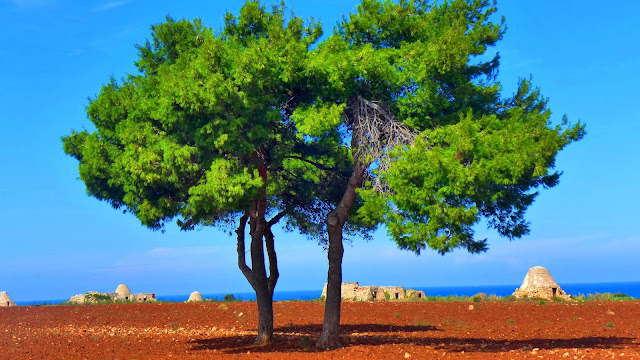Amongst the Trulli
Amongst the Trulli
Trulli are the most unique of homes - as unique as you will see anywhere in Italy, maybe in Europe. These small homes are sometimes grey-toned the colour of concrete, and sometimes whitewashed in the purest of white on white. The roofs are sometimes concrete topped, but more often they are a mound of stacked shingles in their various earthen colours. Dark toned wooden doors and small shuttered windows make these singular dwellings as similar as peas in a pod. In the countryside the Trulli are sometimes single, but more often clustered in groups of three or four. The countryside is dotted with these. From vantage points looking out across the Itria Valley there are hundreds, perhaps thousands of these small humped roofs visible.
 Alberobello is the heart of Trulli country. The prettiest of towns in itself, the Trulli quarter is completely unique to Alberobello. It is as surprising as a traditional African village might be in the middle of a city. The Trulli cluster up a low hillside, roofs rising one above the other. Small lanes of flagstones weave in between the Trulli. Tourists are drawn like magnets to this enclave and many of the Trulli have been converted inside to small shops and homestays. On the interior the spaces may be compact but are still full of charm.
Alberobello is the heart of Trulli country. The prettiest of towns in itself, the Trulli quarter is completely unique to Alberobello. It is as surprising as a traditional African village might be in the middle of a city. The Trulli cluster up a low hillside, roofs rising one above the other. Small lanes of flagstones weave in between the Trulli. Tourists are drawn like magnets to this enclave and many of the Trulli have been converted inside to small shops and homestays. On the interior the spaces may be compact but are still full of charm.
In the summer the minimal windows mean that the interiors with their thick plastered walls, remain cool and agreeable. In the high dome roofs there is usually a mezzanine platform reached by a tall ladder. The platform was the sleeping space in the traditional Trulli home. The larger Trulli were built close together with one merging into the other to create extended more usable family living spaces. Often there were traditional Mediterranean flat roofed homes built around Trulli, with the domed roofs poking through the flat surrounds to provide the distinctive conical cap. Many of these still survive in the fields surrounding Alberobello.

Originally Trulli were built as animal shelters, grain stores and peasant homes. Increasingly abandoned in the late twentieth century it was only essentially tourism which saved the Trulli from destruction. Today Trulli are refurbished for visitors to the region and for business, but few are still lived in as homes of choice by the locals. Now under the protection of Unesco as a World Heritage Site, the Trulli village of Alberobello is thriving once more. In the surrounding villages of Locorotondo and Martina Franca many clusters of Trulli also remain.
Across the fields on the roads leading out of the region Trulli become more and more scattered, some in varying stages of abandonment and disrepair. Others are still well looked after. And then as fast as they began to appear in the countryside, they disappear as you leave this distinctive region of southern Italy behind.
Also Pip McCurdy's New Zealand posts:
On Blogspot, Pip McCurdy on the Road
Website: http://www.unusualstays.com/
https://www.facebook.com/Stay-Somewhere-Strange-273777766054597/
















